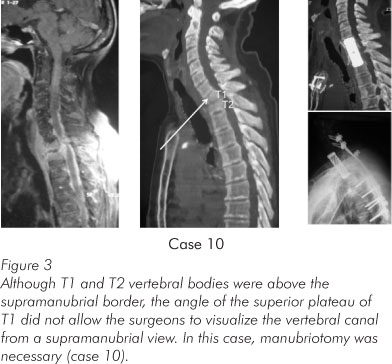OBJECTIVES: the authors report their experience with the anterior approach to the cervicothoracic junction at C7 to T4 vertebral bodies, how the radiological investigation was performed in order to define the need for manubriotomy, how was the surgical pitfalls and the clinical evaluation. METHODS: prospective cohort study with 14 patients who underwent an anterior approach to the cervicothoracic surgery during the period of January 1996 to January 2009. The patients underwent radiographic evaluation with computed tomography and magnetic resonance before surgery in order to identify when the manubriotomy was necessary. The surgery was usually performed from the left side through an anterior Smith-Robinson approach and manubriotomy when necessary. Mesh and cervical plate system were used for stabilization when corpectomy was performed. Nevertheless, in the cases with discal herniation C7-T1, the reconstruction was done with PEEK and cervical plate system. RESULTS: the mean age was 63 years old (range, 30-77 years) and seven of the patients were men. The majority of cases had metastatic disease (n=8) or disc herniation (n=4). There were two complications related to the surgical procedures: one patient with dysphonia caused by a local hematoma and other one with lung infection. The mean surgical time, bleeding volume, pain intensity, medication intake and length of hospital stay were lower in the cases in which manubriotomy was not necessary. CONCLUSIONS: the anterior approach to the cervicothoracic junction is effective and presents low morbidity rate. In cases of injuries involving the C7 vertebral body and C7-T1 intervertebral disc herniation, a transcervical approach without the manubriotomy was indicated; when a T1 and/or T2 corpectomy was necessary, the transmanubrial approach usually was necessary in order to provide a good working space to perform a corpectomy and reconstruction. Performing manubriotomy increases surgical time, bleeding, pain intensity, analgesic drugs intake and the length of hospital stay.
Cervical vertebrae; Thoracic vertebrae; Orthopedic procedures; Magnetic resonance imaging; Tomography, X-ray computed




